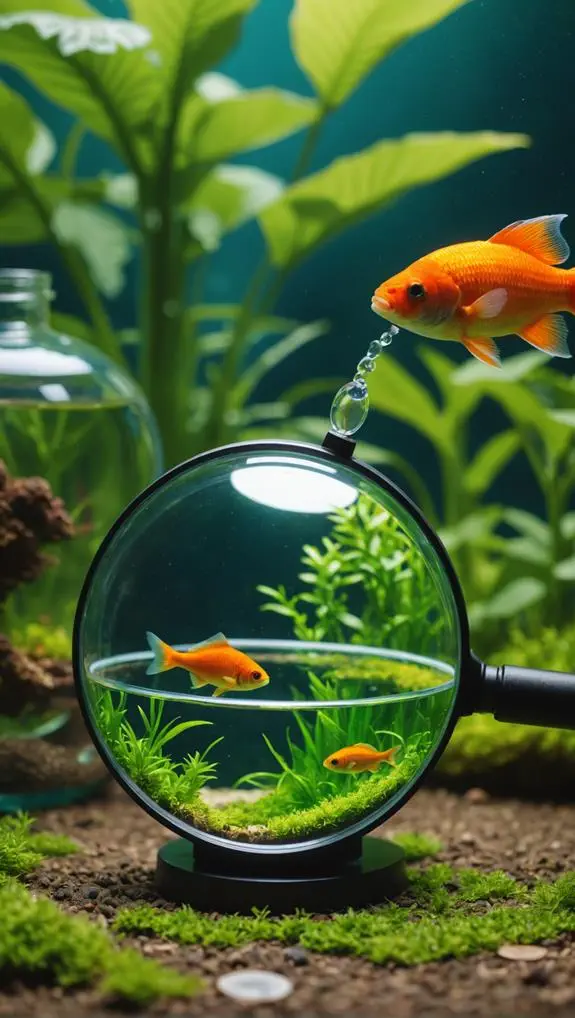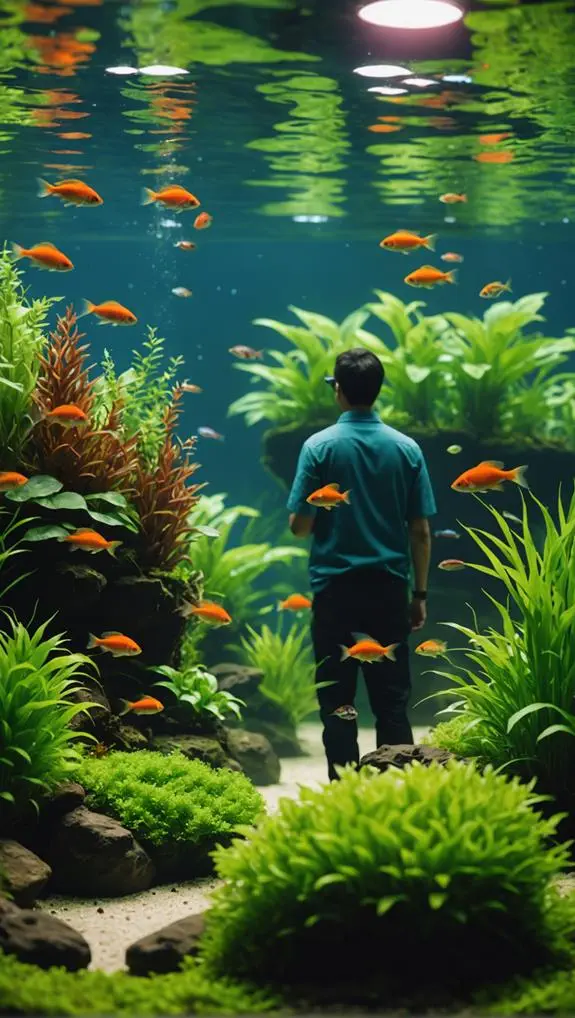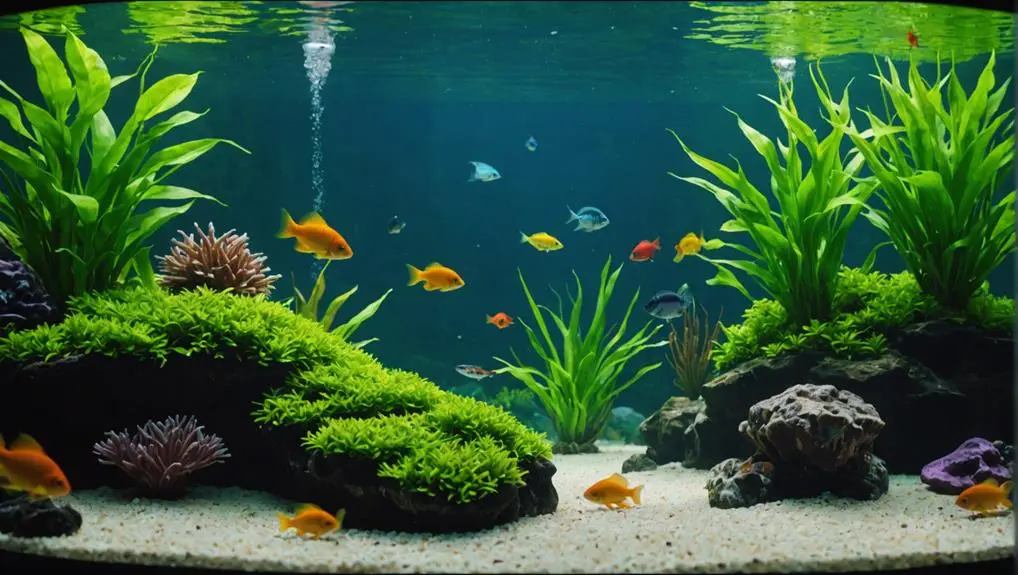To maintain your aquarium's water quality, start by cycling your tank—it's like letting it marinate before adding fish. Test your water weekly for pH, ammonia, nitrite, and nitrate levels; keep the last below 40 ppm. Regular water changes are key—swap out 10% weekly to keep things fresh and clean. Don't forget your filter! Clean it every 4-6 weeks and check for clogs. Feed your fish the right amount—just enough to eat in one minute, and give them a day off each week. With these tips, your underwater pals will be swimming happily, and there's always more to discover!
Contents
Cycling Your Tank
Cycling your tank is an essential step that sets the foundation for a healthy aquarium. Think of it as creating a cozy home for your future fish buddies. The cycling process establishes the nitrogen cycle, which transforms harmful ammonia from fish waste into less toxic nitrites and then into nitrates, all thanks to the good bacteria that flourish in your tank.
Start the cycling with no fish in the tank. You can even use a cycling aid to speed things up a bit!
After just one day, you can introduce a few hardy fish—just three per week to keep things stable. Your fish rely on you to maintain their environment, so it's crucial to test your water regularly for ammonia and nitrite levels. Ideally, you want those levels at zero to protect your underwater pals.
Patience is key here. Rushing the process can lead to new tank syndrome, which isn't a fun experience for anyone.
Weekly Water Testing
Weekly water testing isn't just a chore; it's your fish's best friend!
By keeping an eye on key parameters like pH, ammonia, nitrite, and nitrate levels, you can catch potential problems before they become a crisis.
Plus, with some reliable test kits, you'll have everything you need to adjust water conditions and keep your aquatic buddies happy and healthy!
Importance of Regular Testing
Regular testing of your aquarium water is essential to ensure a healthy environment for your fish.
It's not just a chore; it's a way to show your aquatic friends you care! By testing your water regularly, you can maintain optimal pH levels, ideally between 6.5 and 8.2, which keeps your fish swimming happily.
Don't forget about ammonia and nitrite; both should be at zero.
Even a small spike can put your fish at risk, and nobody wants to be the reason for an underwater drama!
You'll also want to monitor nitrate levels, keeping them below 40 parts per million to prevent long-term health issues.
Lastly, aim for alkalinity between 120-300 mg/L to create stable water conditions.
This helps protect against sudden changes that could harm your fish.
Using reliable test kits, like those from Salifert or API, makes this task easier and ensures you get accurate readings.
Key Parameters to Monitor
To keep your aquarium thriving, you'll want to focus on a handful of essential parameters during your weekly water testing. First up, check your pH levels; they should ideally sit between 6.5 and 8.2. Next, measure alkalinity, aiming for 120-300 mg/L, and water hardness, which should be between 100-250 mg/L.
These water parameters are key to providing a stable environment for your aquatic friends.
Don't forget to test the water for ammonia and nitrite levels! Both should remain at zero to prevent toxicity and keep your fish happy. Additionally, keeping nitrate levels below 40 parts per million is crucial for promoting fish health.
Using reliable test kits, like Salifert for calcium and magnesium or API liquid tests for nitrates, can make this process easier. It's also a great idea to maintain a log of your test results. This way, you can track changes over time and make timely adjustments to uphold optimal water quality.
Adjusting Water Conditions
While monitoring your aquarium's water quality is crucial, adjusting water conditions is equally important for the health of your fish. Each week, test key parameters like pH, ammonia, nitrite, and nitrate. Keeping your pH between 6.5 and 8.2 helps prevent stress or disease in your aquatic buddies.
If your pH is off, you can use buffering agents or acidifiers to make adjustments. Next, check for ammonia and nitrite levels. You want these to be at zero because even tiny amounts can be toxic. Nitrate is another sneaky culprit; ideally, it should stay below 40 parts per million.
If it creeps higher, it's time for some water changes or a look at your bioload—too many fish can mess things up! Use reliable test kits like API liquid tests or Salifert tests, and don't forget to replace them every 12 months. Digital devices can also help with accuracy.
Regular Water Changes

Maintaining optimal water quality in your aquarium hinges on consistent water changes. Regular water changes are essential for keeping your fish happy and healthy. Aim to change at least 10% of the water weekly or 25% monthly. This helps keep your nitrate levels below 40 parts per million (ppm), which is crucial since high nitrate can stress your fish and lead to health problems.
During your water changes, you're not just swapping out dirty water; you're also removing accumulated waste, toxins, and that uneaten food that somehow always finds its way to the bottom. Plus, you're replenishing those essential minerals and trace elements that both your fish and plants need to thrive.
Don't forget to vacuum the gravel during your monthly changes. It's like giving your tank a mini spa day!
Just remember, consistency is key—avoid drastic shifts in water conditions to keep your fish calm and content. They don't appreciate surprise changes any more than we do!
Maintaining Filtration Equipment
Keeping your filtration equipment in tip-top shape is key to a healthy aquarium, and it's easier than you might think!
Make a regular maintenance schedule so you don't forget to clean and replace filter media every 4 to 6 weeks, depending on how busy your tank is.
With a few simple cleaning techniques and tips, you'll keep your fish swimming happily while avoiding any unexpected water quality surprises!
Regular Maintenance Schedule
To ensure your aquarium thrives, establishing a regular maintenance schedule for your filtration equipment is essential.
Think of it as a little routine that keeps everything flowing smoothly—like your morning coffee! Start by cleaning and replacing your filter media, such as synthetic wools and activated carbon. This boosts the efficiency of your mechanical and chemical filtration.
Don't forget to schedule routine inspections of your filter and pump. Check for clogs or malfunctions that could mess with water circulation. Changing filter pads or sponges every 4 to 6 weeks helps avoid harmful bacteria buildup. You want your fish to swim in clear water, not a science experiment!
Monitor any debris in sumps, overflows, and hoses at least once a month. This helps prevent water quality deterioration that could stress your aquatic friends.
Keeping a maintenance log can be your best buddy here; it tracks when you cleaned or replaced equipment, making it easier to stay consistent.
Filter Media Replacement
A well-functioning filtration system relies heavily on the condition of your filter media.
You'll want to stay on top of filter media replacement to keep your aquarium thriving. For mechanical filter media like sponges, aim to replace them every 4 to 6 weeks. This helps prevent clogging and ensures optimal particle removal.
When it comes to biological filtration, don't swap out all your media at once! This can disrupt the beneficial bacteria your fish rely on. Instead, change about 25% every two months.
Now, don't forget about chemical filter media, like activated carbon. They're champs at removing impurities, but they need replacing every 3 to 4 weeks, or they'll start slacking off.
When you're changing out any media, be sure to rinse new media in dechlorinated water. Using tap water might introduce chlorine, which isn't friendly to your beneficial bacteria.
To keep everything in check, monitor your filtration system regularly. Test your water parameters bi-weekly.
If you notice a spike in ammonia or nitrate levels, it's a sign your media might need some attention. Keeping your aquarium clean and healthy is a rewarding journey!
Cleaning Techniques and Tips
Regularly cleaning your filtration equipment is crucial for maintaining optimal water quality in your aquarium. A clean filter means happier fish and healthier water!
Here are some handy tips to help you keep things running smoothly:
- Rinse mechanical filtration components, like sponges and gravel, in old aquarium water to preserve the beneficial bacteria vital for your biological filter.
- Inspect and clean the impeller and other parts of canister and power filters monthly. This prevents buildup that can slow down water flow.
- Check your chemical filtration media, like phosphate removers, and replace them according to the manufacturer's instructions to keep contaminants at bay.
Don't forget to clean and flush undergravel and airlift filters every month. It's a great way to prevent clogging and ensure water moves freely through the substrate.
Remember, you're not just cleaning; you're creating a serene underwater paradise for your aquatic friends. So grab that sponge and let's get cleaning! Your fish will thank you, and you might even score some extra joy watching them swim in sparkling water.
Happy cleaning!
Monitoring Fish Health

Observing your fish closely can reveal vital signs of their health and well-being. When you're monitoring fish health, look for any changes in behavior. Are they hiding more than usual? Have they lost their appetite? Abnormal swimming patterns can indicate water quality issues or infections that might need your attention.
Remember, it's crucial to quarantine new fish for at least two weeks before adding them to the main tank. This simple step can prevent the spread of diseases to your existing aquatic friends.
While you're at it, keep an eye on your water parameters weekly, especially ammonia and nitrite levels. Ideally, both should stay at zero, and nitrates should be below 40 ppm for a happy tank.
Stable pH levels between 6.5 and 8.2 are also essential, as they create a comfy home for both fish and beneficial bacteria.
Familiarizing yourself with symptoms of common fish diseases, like white spots or frayed fins, will help you act swiftly. After all, a healthy fish tank means happy fish, and who doesn't love a cheerful underwater community?
Your fish rely on you, so let's keep them swimming strong!
Proper Feeding Practices
How can you ensure your fish thrive in their aquatic environment? One crucial aspect is adopting proper feeding practices. By feeding your fish the right way, you not only meet their nutritional needs but also help maintain water quality.
Here are some tips to keep in mind:
- Feed a varied diet: Include high-quality staple foods like pellets or flakes, along with natural protein sources such as black soldier fly larvae.
- Watch the portions: Offer only what your fish can consume in about one minute to avoid overfeeding, which can lead to water quality issues.
- Establish a routine: Create a consistent feeding schedule, ideally once or twice a day, based on your fish species' specific dietary needs.
Don't forget to skip feeding once a week! This gives your fish a chance to detoxify and helps keep the tank cleaner.
Remember, different species have unique dietary requirements, so be sure to cater to those needs.
Temperature Management

Maintaining a consistent water temperature is essential for the health and well-being of your fish. Ideally, you want that water temperature between 74-82°F (23-28°C). Fish are sensitive creatures, and sudden temperature changes can stress them out and weaken their immune systems. So, grab a reliable aquarium thermometer and check that temperature daily—your fish will thank you!
Investing in a quality heater with a thermostat can make a world of difference. This nifty device automatically regulates the water temperature, preventing those pesky fluctuations.
But what if the heater goes on the fritz? Consider establishing a backup heating system or using a temperature controller to keep things stable, just in case of power outages or equipment failures.
Don't forget about external factors! Room temperature and direct sunlight can sneakily influence your tank's heat. If you notice your tank getting warmer than a summer day, take steps to shield it from those rays.
Lighting Considerations
Lighting plays a vital role in the health of your aquarium's ecosystem. It's more than just a pretty glow; the right lighting helps your plants grow and keeps your fish lively. For a flourishing freshwater aquarium, aim for about 8 to 12 hours of light daily.
Here are a few tips to keep in mind:
- Choose LED lighting: They're energy-efficient and produce less heat, making them ideal for your setup.
- Mimic natural sunlight: Too much light can lead to pesky algae, while too little might leave your plants feeling neglected.
- Keep those light fixtures clean: Regular maintenance helps prevent algae buildup and ensures your plants get all the light they need.
For optimal growth, aim for color temperatures between 6,500K to 10,000K. This range is perfect for promoting healthy plants and vibrant fish.
Also, consider using timers to maintain a consistent lighting schedule—your aquatic buddies will thank you!
Disease Prevention Strategies

Disease prevention is crucial for keeping your aquarium thriving and your fish healthy. To start, always quarantine new fish for at least two weeks before introducing them to your main tank. This simple step helps you monitor health and prevents the spread of diseases that could be toxic to fish.
Next, make it a habit to regularly observe your fish. Look for any signs of stress or illness, like changes in appetite or unusual swimming patterns. If you spot anything off, it's better to act early!
Keeping your tank clean plays a big role in disease prevention, too. Aim for weekly water changes of 10-25% to dilute toxins and remove waste. This not only reduces stress on your fish but also helps prevent disease outbreaks.
Don't forget to use a high-quality water conditioner to eliminate harmful chemicals from tap water!
Lastly, invest in a variety of fish foods for balanced nutrition. Just remember, overfeeding can lead to water quality issues, promoting harmful bacteria. So, keep those portions in check!
With these tips, you'll create a healthier environment for your underwater friends. Happy fish-keeping!
Frequently Asked Questions
How Do I Keep My Aquarium Water Healthy?
To keep your aquarium water healthy, ensure fish compatibility, perform regular tank cycling, and conduct water testing. Use effective filtration systems and implement algae control methods to maintain a stable, thriving environment for your fish.
How Do I Improve My Aquarium Water Quality?
To improve your aquarium water quality, start water testing regularly, adjust filtration systems for efficiency, manage algae control, ensure fish compatibility, and maintain proper temperature regulation. These steps create a healthier environment for your aquatic friends.
How Do You Maintain Water Quality in a Tank?
To maintain water quality in your tank, perform regular water testing, utilize efficient filtration systems, manage substrate maintenance, control algae growth, and prioritize fish health. These steps create a thriving environment for your aquatic friends.
How Do I Keep My Aquarium Water Clean Naturally?
To keep your aquarium water clean naturally, focus on plant integration for natural filtration, encourage beneficial bacteria growth, select compatible fish, and conduct regular testing to maintain a healthy environment for your aquatic community.
Final Thoughts
Maintaining aquarium water quality can feel like a juggling act, but it's totally doable! With a bit of routine and care, you can create a happy home for your fishy friends. Think of it as a dance—you just need to find the right rhythm. So, grab your testing kit and get started! Your aquatic buddies will thank you with their vibrant colors and lively antics. Remember, a clean tank means happy fish, and that's a win-win for everyone!












